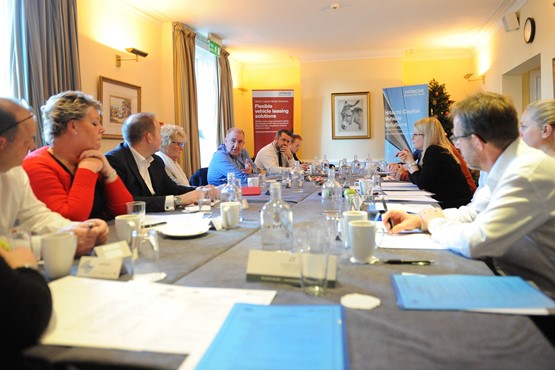Some of the risk management solutions that can bring benefits to a business were discussed at the latest Fleet News roundtable, sponsored by Hitachi Capital Vehicle Solutions. But, they require upfront investment and often a culture change within the company.
While most fleets already utilise telematics, the influx of camera-based systems has introduced a new wave of opportunities for operators to assess the training and development needs of drivers.
Significant cost savings can be achieved by getting risk management right, but fleet operators must also consider the wellbeing of the driver.

Fleet News: What are you doing to manage risk?
Gareth Wilsher, international fleet manager, AT&T Global Fleet Operations: We have a fairly low mileage fleet which helps reduce the risk, but we work with the IAM to do our driver assessments and development courses. General annual risk assessments will then lead on to an array of further courses and even on-the-road work with an advanced driver if need be, clearly balancing cost with managing the risk.
We also have an independent accident management provider who we have introduced to IAM and they are actually working together with other clients now. It’s working well, we are getting some good data back on the profiles of our drivers. The trends are the key thing. You see some blips, but we are looking for continuation of trends and these are the people we want to focus on and take corrective action with.
Jonathan Brown, fleet and facilities executive manager, Princebuild: Our driver training starts on day one. We give a two-hour presentation and then take them out on the road where we talk about eco driving, space management and defensive driving.
When we see the drivers for their annual vehicle check we run through their telematics with them. I spend about half an hour with them running through the harsh braking and harsh acceleration.
We also do a monthly over speed report and write to the drivers to let them know if they’ve been speeding and could face disciplinary action. That has been really effective.
It generates a bit of competition between drivers. On a quarterly basis, I let them know where they rank (for overall driving).
Martin Edgecox, fleet project manager, Highways England: We’ve just begun a new trial with Masternaut. We decided not to use the ‘traffic light’ system as it could be a distraction.
We’ve previously used telemetry to terminate supply chain providers. We caught some of our vehicles speeding while being collected or delivered for maintenance.
We also use cameras. Our CCTV cameras are front- and rear-facing. We are talking about having them ANPR-linked (automatic number plate recognition) to help the police.
Peter Bell, senior category manager, British Gas: Mobile phone usage is banned in our fleet. It is gross misconduct for our employees. I leave my phone in the boot.
It does cause debate in our business. There is no question that it will cost us productivity. The number of conference calls we have to make from motorway services costs time but our leadership team is really passionate about it.
Our guidance is to pull over and call the person back. Even our customer service centres will not take a call from someone who is clearly driving at the time of the call.
Has anyone quantified a risk management strategy?
Mandi Nicol, fleet manager, Schneider Electric (below): Our insurance came down by £39,000.

Peter Bell: We took a sample of drivers’ telematics scores before and after installing a forward-facing camera. We have noticed a reduction in hit third party, but putting an absolute value on that is difficult because we also fitted our vehicles with autonomous emergency braking, which will also have a positive effect.
Jonathan Brown: Introducing a league table of driver performance dropped the fault accidents by 60%.
We have seen fuel savings. All our drivers use similar vehicles, so I talk to those that are getting worse mpg about how they can improve their driving to save fuel.
Adam Baillie, head of fleet, Comex 2000: Our savings have come from idling. We reduced fuel cost by £1.5m in the first year.
Should drivers be offered incentives for good driving?
Jonathan Brown: We don’t use rewards. I have suggested we give some incentive, but it was declined. I don’t hit drivers with a stick. It’s more dangle the carrot and work with them and create a bit of an education piece. When I try and explain the benefits, it’s because, financially, fleet is an overhead of the business.
Therefore, if they can help reduce that there could be other benefits for them. I think if we gave a reward to the top 10 it would be the same people winning again and again.
Peter Bell: Supply chain and safety organisations are often keen to help out with things like this. We are just launching a driver of the year competition and have reached out, with good success, to our suppliers and partners. Throwing money at them isn’t necessarily the right way but you do have to provide some incentive.
Adam Baillie (below): I agree with using league tables. We’ve never used any incentives, which is a bit unfortunate. We would like to see something introduced. Not rewarding drivers is pretty poor in the industry. How do you get the ones off the bottom?
Good driver management will improve your CO2 and reduce fuel consumption, but if you save money no finance director will let you use that as an incentive.

Paul Taylor, fleet manager, Morgan Sindall: We focus on cost and safety, but how often do we focus on the wellbeing of the driver? The wellbeing of the driver could affect your costs, mpg and everything.
How do you manage grey fleet risk?
Paul Taylor: We treat them the same as a company car driver. They are issued with a company car handbook, they go onto the licence check system that also deals with insurance, MOT and age of vehicle. The vehicle has to fit in with parameters set by HR.
Jonathan Brown: We stipulate that vehicles have to be no more than four years old. It is relatively new to us but we manage it the same way as we do a company car. You have to be careful with insurance. Sometimes we have to contact the insurer to confirm that the driver is covered for business use.
Mandi Nicol: Usually, if you point out the Corporate Manslaughter Act and what they are exposed to, the business responds better.
The delegates
Mark Benson, business development manager, Hitachi Capital Vehicle Solutions
Paul Taylor, fleet manager, Morgan Sindall
Peter Bell, senior category manager, British Gas
Mandi Nichol, fleet manager, Schneider Electric
Sandra Holden, company car and business manager, TNT UK
Jonathan Brown, fleet and facilities executive manager, Princebuild
Maria Groves, fleet and facilities supervisor, Princebuild
David Armstrong, business development manager, Hitachi Capital Vehicle Solutions
Gareth Wilsher, international fleet manager, AT&T Global Fleet Operations
Martin Edgecox, fleet project manager, Highways England
Jo Pavely, procurement delivery partner, Highways England
Adam Baillie, head of fleet, Comex 2000
Paulo Larkman, national fleet consultant, Hitachi Capital Vehicle Solutions





















Login to comment
Comments
No comments have been made yet.